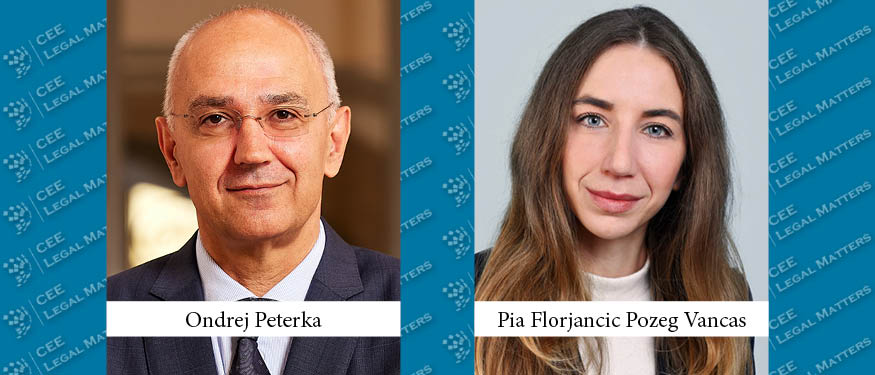On January 30, 2018, a select group of prominent Serbian lawyers gathered at the Prica & Partners law firm in Belgrade for a CEE Legal Matters Round Table to discuss the current economic conditions in Serbia and the country’s legal services sector.
Round Table Participants:
- Darija Ognjenovic, Partner, Prica Partners
- Gligorije Brajkovic, Head of Legal and Compliance, Unicredit Bank Serbia
- Mladan Marjanovic, Partner, Marjanovic Law
- Marjan Poljak, Senior Partner, Karanovic Nikolic
- Slobodan Kremenjak, Partner, Zivkovic | Samardzic
A Successful Year Across Sectors
The conversation started on an enthusiastic note, with general agreement that 2017 had been good, and reports that 2018 was starting off similarly well. “The economy is more mature than ever,” said Marjan Poljak, Senior Partner at Karanovic Nikolic, who reported that while in the past Serbian lawyers were dependent on the hit-or-miss dynamic of isolated big deals, the work coming to lawyers in the market these days is more consistent – “more and more of the usual stuff.”
“One can argue that Serbia is stable because the political situation – such as it is – is not undergoing any serious changes,” said Gligorije Brajkovic, Head of Legal and Compliance at Unicredit Bank Serbia. As a result, “the economy is definitely doing better,” he said, pointing to an increase in the request for products received by his bank. Although he conceded that there has been a small drop in actual demand, which he says is tied to this being an election year, he insisted that he expected to see an uptick in 2018 from 2017 – a year that was already, he says,“demanding for us as a bank.”
And even though Serbia remains outside it, the EU influences the country’s economy – and the bottom line of the country’s law firms – in significant ways. According to Darija Ognjenovic, Partner at Prica & Partners, her firm is seeing a considerable amount of work stemming from efforts to harmonize with EU legislation in areas related to Company and Data Protection Law, among others, and she said she was particularly enthusiastic about potential in the renewables sector, reporting that there are four large projects already underway financed by the IFC.
On the deal-making side, Mladan Marjanovic, Partner at Marjanovic Law, described 2017 as a successful year. Poljak agreed, pointing to deals ranging from the EUR 125 million acquisition by OTP Banka Srbja A.D. Novi Sad of Vojvodanska Banka, NBG Leasing, and a portfolio of Serbian-risk corporate loans, to some large PPP projects and several large wind farm financings through the IFC and the EBRD, and he reported that he and his colleagues are already seeing an increase in the number of projects planned for this year.
Although Ognjenovic noted that consolidation in the bank sector has also produced a good amount of work for lawyers, not everyone was so confident about that work going forward. Slobodan Kremenjak, Partner at Zivkovic | Samardzic, pointed out that while several notable deals did indeed take place in the sector last year, they primarily involved Greek bank exits – as the OTP Banka acquisition Poljak had referred to had – and wondered whether the increased amount of business was actually the result of conditions in Serbia or represented, instead, “matters that spilled over from elsewhere.” If the latter, Kremenjak suggested, expectations that the level of activity would continue might be misplaced.
Ognjenovic made a similar point about the level of NPL transactions last year, which failed to meet predictions, and she pointed out that NPLs are rarely a subject of conversation in the beginning of 2018. Brajkovic, speaking from a bank’s perspective, explained that level of NPLS in the banks sharply dropped as this is primarily result of good risk policies, previous disposals done by the banks on the market and several legislative updates that made NPL go off-balance.
The banks aside, though, everyone agreed that the number of mid-sized deals in Serbia had increased – and that they expected that increase to continue in 2018. Kremenjak insisted that these deals are just as critical to law firm bottom lines as large deals, which come less often. In his words, firms “won’t turn their back on either.”
Of course, it would be absurd to suggest large deals aren’t eagerly sought-after. Ognjenovic pointed out that firms are happy to have “a few huge ones to work on, not just in terms of revenue but also to have as a good reference.” And Poljak reported that “seeing large investors coming into the country is a positive sign and instils confidence in the market.”
The Law Firm Market: Growth With a Pinch of Competition
The stability in the Serbian economy appears to be the name of the game for the legal market as well. Ognjenovic, for instance, reported that the team at Prica & Partners had increased a bit in size in 2017 and that she expects it to remain steady in 2018, and Poljak reported that Karanovic Nikolic registered steady growth in their various offices as well.
Marjanovic reported that his team at Marjanovic Law grew last year as well, albeit less than it had in previous years: “This is likely the case because we are one of the younger firms and it is easier to grow at this stage. Serbia is however a relatively small market with ten firms or so dividing the bulk of a market worth about EUR 50 million – maybe even less – so I think increasing past a certain level is difficult.”
The buoyant Serbian economy that justifies steady growth by existing firms also appears to be providing incentive for the launch of new ones, as Kremenjak reported the recent arrival of a number of spin-offs in the market lately – “an increase in the number of smaller, but very capable firms, ready to execute solid work with considerably lower overheads.“ Although he said that “none have gutted any of the large players” so far, he described these split-off firms as consisting of “battle-tested lawyers.” He noted that the fact that none have yet merged among themselves or joined other larger firms meant there is still room in the market for them.
Split-off firms, usually smaller and less established on the market, traditionally make attractive financial offers to potential clients. Indeed, Ognjenovic described the split-offs as representing “serious competition for us because they can offer lower fees.” And speaking from a client’s perspective, Unicredit Bank Serbia’s Brajkovic, who says he retained one of the recently split-off firms last year to work on a mid-sized deal when the bank’s go-to firm was conflicted out, was impressed. “They showed pretty good work, I have to admit, and the price was only half.”
Of course, the need to keep fees low while continuing to grow in size is a trick few firms, if any, have been able to master, and Kremenjak conceded that his firm, for one, will probably be forced to raise its fees as it evolves from a boutique into a full-service market participant.
To this Brajkovic encouraged him and the other participants to remember that price alone – while obviously important – is rarely dispositive. “Price is a part of it, sure,” he explained, “but it does come down to a specific lawyer. If the firm grows and they can’t give me the person I am used to working with anymore, that’s where the real questions will start coming up.”
The Belgrade Beacon
Ultimately, triggered by Poljak’s claim that his firm – Karanovic Nikolic – manages to escape fee pressures by virtue of its regional capabilities, the conversation turned to the different strategies Serbian firms employ to assist clients beyond the country’s borders, as all agreed that a significant amount of their work comes in the form of referrals from international law firms, which are traditionally uninterested in having to arrange separate local partners for each Balkan jurisdiction.
Poljak explained that his firm chooses to follow an integrated approach to its multi-jurisdictional coverage, which he said “provides a comparative advantage,” noting that the strategy required great flexibility to ensure colleagues in jurisdictions across the Balkans were able to comply with varying Bar regulations.
Kremenjak and Ognjenovic, in contrast, explained that their firms chose instead to identify partners in neighboring markets with whom they can cooperate at a consistent quality level, with Kremenjak reminding the table that the identification process is not always easy: “Sometimes you need to make mistakes with a couple of firms before you identify the right partner but, once you do, it can be built into a truly beneficial relationship to both sides.” Ognjenovic agreed, noting that it took her firm “several years to identify the right partners,” before she and her colleagues finally developed the confidence to formalize a regional network.
Regardless of the model, the development of formal and strategic multi-jurisdictional strategies makes sense in light of Belgrade’s central importance for the region. Poljak pointed out that this is significant not only in terms of Belgrade-based cross-border work between Balkan states, but also because a lot of non-Balkan investors come into multiple Balkan markets at the same time, usually using Belgrade as a base and/or point of entry.
And it appears law firms in Serbia, and around the region, are ready for the challenge. “I think the markets are a lot more developed now,” Brajkovic said, concluding the conversation on an optimistic note. “The benefit of law firms here evolving and looking beyond Serbia is that the country is really becoming a beacon for the region and they are setting the tone for how legal services are being offered.”
This Article was originally published in Issue 5.2 of the CEE Legal Matters Magazine. If you would like to receive a hard copy of the magazine, you can subscribe here.

























